Butter Werks
I pretty much take what I do every day for granted, forgetting that what is habit to me and mine is a whole new world to others. Especially if they want to farm, or are longing to reconnect with their heritage, or are just plain curious about farmsteading in general. Many of the tasks I do every day are etched in my memory bank so deeply I don’t give them a second thought. So I thought maybe a post about the care of Jane’s winter quarters might be useful and timely. When people ask me about getting a milk cow, most questions center around the task of milking only. Not the barn cleaning part. What’s to know?
Well, actually a lot. Cleaning your milk cow’s sleeping quarters is as important as cleaning your milk bucket. It doesn’t matter if you have one dairy cow, or hundreds. Manure handling is an important and daily chore. Grazing season is a little different, Jane is outside day and night and only comes in for milking, but now she needs to be in at night just to get a chance to dry off and rest. It may not get cold here in the Pacific Northwest, but it rains most days from now until April. A cold, wet cow uses a lot of energy just to keep warm. Energy in the form of hay, that we have to make and haul in during the summer. Hard work I don’t want to waste.
Jane actually is a little spoiled. Well, a lot spoiled. But not really because she is Jane, it’s more because the design of this loafing shed just isn’t good for deep bedding like we use for the beef cows. Plus deep bedding is not what you want for a dairy cow anyway due to the size of their udder. Beef cows as a general rule don’t have pendulous udders that touch the ground when they lay down.
After Jane is milked and put out to pasture, the milk is processed, I eat breakfast, gulp down some more coffee and go out and do my barn chores. I get annoyed with myself if I leave this chore until afternoon. When it is time for evening milking I want to just go out and milk, so having the barn night-ready makes me feel better. This is about like washing dishes before you start to cook, it just goes easier. Having manure chores separate from milking chores is a wise thing to do.
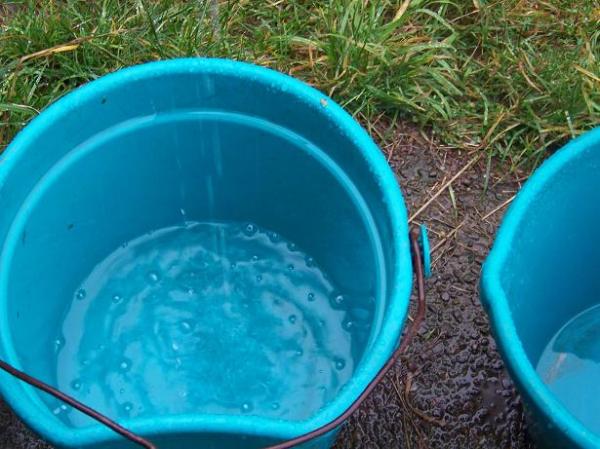
My first order of business is to remove her water buckets so they won’t get manure or soiled bedding in them when I push the loaded wheelbarrow past them. If it’s raining I put them under the gutter on the implement shed. If it’s not I take them to the water trough for filling. Rain is nice, I don’t have to pack the buckets so far.
Jane is pretty good about making a little nest for sleeping in a clean area of the shed. I like this. If she doesn’t feel good she is apt to lay in her own poop. It’s not true of all cows I guess, but I have noticed that cow that are ill or slightly off tend to just not care where they lay down. Kind of like us when we have the flu, who cares if you comb your hair, you feel like crap. If your cow is chronically dirty, your cow area may be too small, or you’re not using enough bedding. It happens, but you basically don’t want to see manure on the cows. A clean udder makes my job much easier to produce clean milk. As it is, if Jane does have manure on her udder, I don’t keep the milk for the house. I still have to clean her and milk her, but it makes more sense for me to discard the milk. The chickens don’t mind a bit.
The loafing shed has a dirt/rock floor. In the summer we put down shavings, and I add straw to the top of that. The shavings absorb the urine and the straw is there mostly because I want this material for the gardens. Shavings are great if you can afford them, but the carbon to nitrogen ratio is too high for garden compost, unless you have years to wait for it to break down. It’s good to note here too, that shavings or sawdust on top the ground is a good fertilizer, but since I am tilling this material in and basically burying the shavings before they could break down, using straight shavings isn’t the best for my garden situation. It’s also good to note too on the cow side that the shavings must be kiln-dried or you run the risk of Klebsiella bacteria possibly causing mastitis.
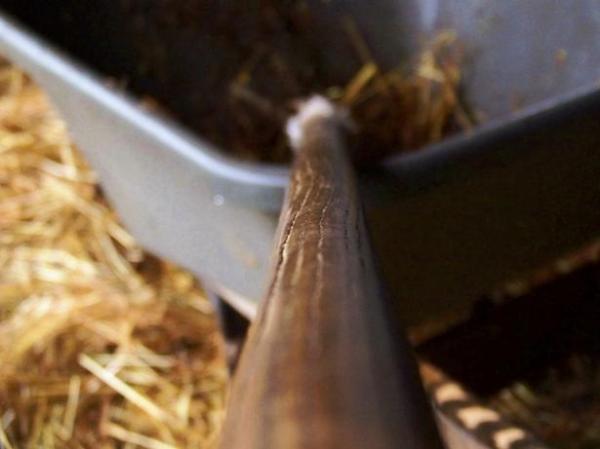
Like any other chore the right tools make the job go easier. I have a dedicated manure wheelbarrow, and a five tined manure fork. The handle is so smooth you wouldn’t believe it, a testament to how much I have used it. This old post about barn forks explains a little more of the hows and whys of pitchforks.
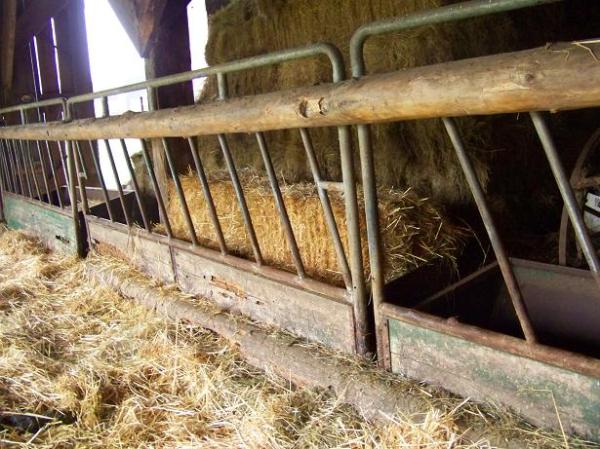
When we built this loafing shed for feeding we didn’t do deep bedding and these feeder panels are fixed in place. We tried to deep bed once, and what a fiasco to clean since we have end walls on this barn. The feeder gate spacing is a pain too, just ask Jane. I look forward to the day this whole thing is cut apart and gone and we can replace it with something that works better.

Basically to clean the “stall” I am picking it, which means I am looking for any soiled areas and picking those up. Much like you see the stalls kept at fairs or shows.
Of course, you must have quality control with barn cats and calves.
After picking the stall, I have to bed it with fresh straw. Cut the twine at the knot and cover all the soiled areas in the stall with fresh straw. I have handled so many bales of hay in my lifetime that if the knots are down I can flip the bale with a flick of my wrists before you could blink an eye. And I always have my knife in my pocket.
After bedding, I add Jane’s hay and we’re good to go until the next morning.
I know this makes it seem cumbersome to clean up after a cow, but to tell the truth I don’t have to think about most of it, like where to fill the buckets, or cutting the twine at the knot for recycling. It actually took me longer to take the photos than the actual chore of cleaning up after Jane. But I think this chore is probably the most important ten minutes of my day.

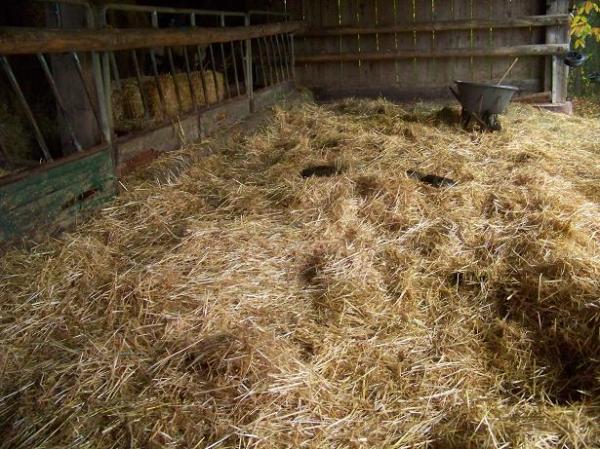

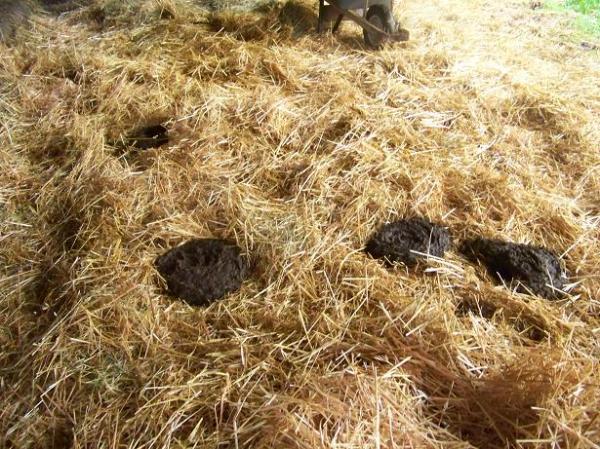
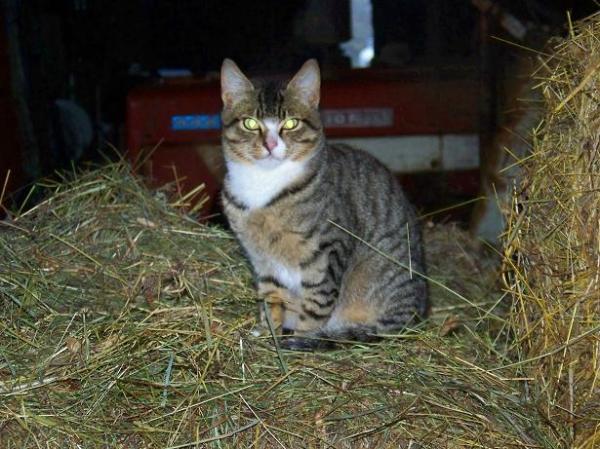
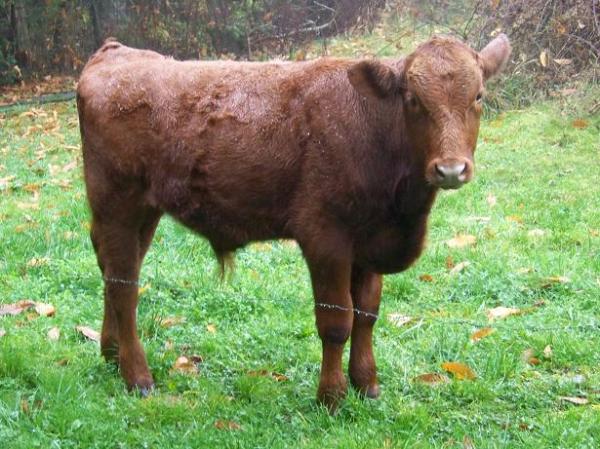
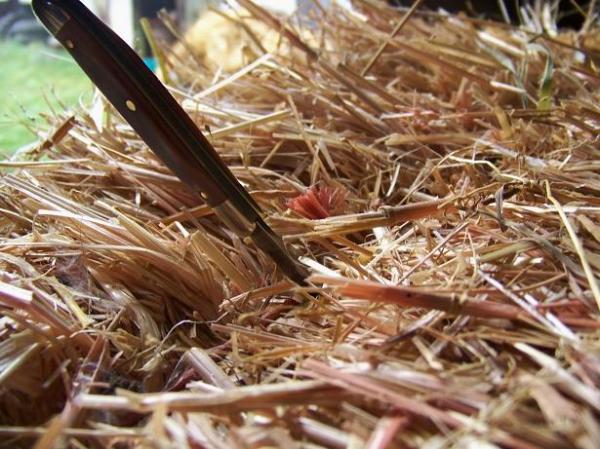
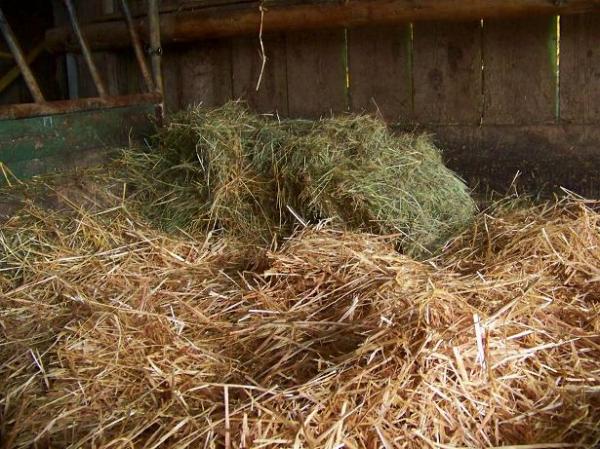
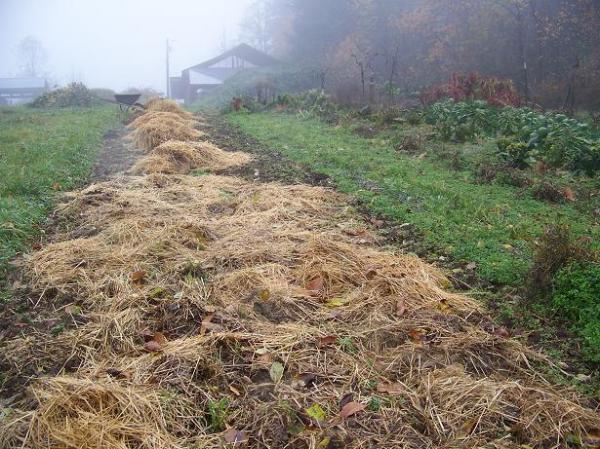


Your animals are very good about looking into the camera. 😀
Lisa G, they just love me for food 🙂
Jane is one lucky cow! 🙂 do the beef cows stay out all winter or do you have shelter for them too or do they even need it?
Chris, that’s what I keep telling her 😉 The beef cows stay out a little longer, depending on snow. Maybe next month?
Wouldn’t it be more efficient just to build a freestall for jane to keep her udders clean and leave the rest unbedded? yes, you can do this chore every day but since she’s going to lay down in random places, she’s going to get manure on her udder more frequently than if she was in a freestall environment.
Bruce, not really, since she has only had manure on her udder twice this lactation (since mid-June) and that was when she was in the pasture 24/7, so with one cow it’s not really a problem, and with a freestall you’re not really stopping the cow from manuring, and you will still have to remove it and replace the bedding that was soiled. I doubt with one cow, with free access to the outdoors that she would even use the freestall unless I tied her in there in the old tie stall fashion. So I would really still be removing manure by hand, since it wouldn’t pay to fire up a tractor to scoop out a wheelbarrow’s worth of manure and bedding a day. With your setup and more cows freestalls definitely make sense. So I’m thinking for my setup and my cow, this will keep working like it always has. 160 days in milk, 320 milkings, 2 milkings with a trace of manure on the udder. That’s much better than many can say.
You’ve already got a nice dairy barn but for other folks, here’s a good plan for a small holding or small dairy with freestalls.
Jane is blessed to have you. What a haven for the night on cold wet days. We know that your milk has to be wonderful. Healthy cow and healthy environment. I try to get our milk from sources close to our area. I cringe thinking about what care some cows receive. There are some name brands I won’t buy. Don’t know of one family in our valley that has a milk cow. Sad. When our family was young we had a cow. Just two of us now.
A knife is the tool of choice. Every pocket needs one. Can’t count the times when one has come in handy.
What a lucky girl Jane is! Our cows can stay out all year – though we have to cart hay to them – the temperatures here rarely get to even a frost (maybe 7 times in total this year). My milking girl lying in her manure doesn’t happen that often – I hate the clean up when it does – I cook it up as ricotta for the chickens when it does.
It’s pretty mild here too, most winters, just wet. We’re pretty lucky our soil can take all the rain and not make mud except in high traffic areas, so it’s everyday out too here. Ricotta here too for the hennies – in the winter they enjoy it!
By the looks of it, Dickie R has his winter coat? Handsome feller. Is he out with the big boys yet?
Carrie, he’s out and keeping the horse company. I don’t know who is worse for being herd bound 😦
So then do you have another large structure for them or do they go to the same barn as Jane? If so, does she like their cowpany? 🙂
Chris, they have their own barn, and Jane the other cows have agreed to disagree.
Good post 🙂 I think a lot of people don’t consider the ‘other’ jobs when thinking of getting a house cow… It’s not all milk and cream 😉
I wish every person with livestock would read your blog! People don’t realize how important manure management is. So wasteful and terribly polluting, drives me crazy, especially when it’s friends who think they are being so sustainable…
LOL @ Jane having her own room. As usual, Nita, a splendid practical post on how to care for livestock. Thank you.
“Manure handling is an important and daily chore.” Amen!
Thank you for all those details! I love learning from you. Our climate is different and I have to adjust accordingly, but I’m still learning a lot from you.
I’m a newbie to all of this and don’t have cows, But I milked a friends goat 3 times a week for about 2 years, but I’m curious about the manure on the udders. Even if you clean and sanitize the udders and strip the milk, there is still a high likely hood of contamination?
Thanks – I am glad I came across your blog. I am getting lots of good info for my future farmstead. And I’m expecially glad your are also in the PNW!
ok – typos all over the place! I wish there was an edit button. I have a few more buts than I need, punctuation/initial cap problems and “expecially” should be “especially”. Really – I’m not as dumb as I may look!
LFF, welcome PNW’er! Yes, you can clean the udder thoroughly enough to save the milk. Not much water for cleaning, pre and post dipping helps a lot. I don’t feel compelled to save the milk on the rare occasion my cow does get her udder dirty, because my husband has some immune system problems. Not worth the risk in my opinion. Chickens and pigs can make great use of the milk though. The other concern is the risk of mastitis, most are environmental in nature, which means clean, clean, clean. It’s easier to help the cow keep the udder clean than it is to clean it. Usually providing enough space, the correct type of space and clean bedding is the way to go. Especially here in the PNW, wet weather is the worst.
Do you buy straw or are you growing grain? We don’t eat or feed grain which means we are buying our straw and we’re finding the cost prohibitive. I find myself rationing it which is not a good thing (especially so early in the season).
We have a divided loafing barn and separate tie and box stalls (converted from old Begian horse stalls). Our cows only come in the stalls for milking. We’re in Northern Canada. It gets quite cold on some days. I rely on deep bedding to warm the ladies in the loafing barn so I’m hesitant to pick up too much manure, preferring to get the bacteria doing its warming thang. I’m not sure what’s best in our situation so for now it’s a semi deep bedding situation where I pluck of the patties every couple of days. Your post has me thinking I should be doing this ever day, but how will that impact on the biological activity that’s creating warmth, much need warmth that is?
COF, I do buy straw and we buy it from the grower, so that helps on the expense. For us it would be much more expensive to outfit ourselves to grow and put up grains. Since we don’t use that much grain anyway ourselves. Then we have our weather, it could be done, but it’s right up there with buying a bull.
Your barn sounds like mine, the Belgian tie stalls now store other things…potatoes, cow minerals, soil amendments etc. I find in our deep bedding situation we use a lot of straw to keep the cows warm and dry. But that is a different barn, that we can access from the ends for cleaning out the bedding.
As it is, we put down shavings about 6 inches deep in this loafing shed, covered with straw and then I add about 3 or 4 flakes a day to replenish what gets taken out when I pick the area. We don’t have the cold temperatures that you do. I would guess that as long as your girls stay clean the deep bedding would work fine. Our deep bedding for the beef cows gets up to, and stays at about 100 degrees F after it reaches the foot mark.
The other constraint I have too, is that this barn I’m using for Jane is hard to clean with machinery and the deep bedding is awful hard on the wood part of the structure. With one cow I can keep up easily with her output. She spends the days out, no matter what the weather, so I am only dealing with her night soil.
You are very good. Yes, you’re like a revolution waiting to happen. A marinating revolution. if I knew half what you knew … oh, who knows what might happen?
With each well worn fork the world will be moved. Each wheelbarrow full regulates the spin of the earth. Each young reader nourished on kindness and manure and revolution.
If I could ask, would you be willing to go into detail about shavings being bad for the soil. I bring in manure from a horse barn that uses shavings as bedding. It sits and composts for probably 6 months before I bring it home. I know that wood breaking down leaches nitrogen. Is that the only thing bad? Or are there other things? Can you recommend reading that goes into detail on this subject? Thanks Matron. You are so wonderful!
Michelle, it’s nothing that time won’t cure, the tilling in is the problem, because the soil critters have to work so hard to break all that carbon down and that is what is robbing the nitrogen. Think of nature – trees fall down and take years to rot down. We have down trees here that have been lying on the ground for 80 years or more, and they are still recognizable as downed trees. Then think of grass and how quickly it breaks down. Straw is basically grass whereas shavings are basically trees. We get horse manure and shavings too from a horse stable. The woman we get it from waits about 5 years to use it on her extensive gardens, we reuse it in our compost building, deep bedding etc. I think if you have the source keep getting it but use it on top the ground in a Back to Eden sort of garden, or maybe in paths to eventually rot down and make soil. Some say it can be too acidic, or release tannins, but I have no idea exactly how much since I don’t really use in areas we till. We spread it directly on the pasture and it works great. Garden not so much.